- US and world equity markets soar on news Trump could be considering $1 trillion infrastructure spending, adding to Fed’s expanded bond-buying.
- Fears of a second COVID-19 wave linger, offsetting bigger gains on increased liquidity
Key Events
US futures for the S&P 500, Dow Jones, NASDAQ and Russell 2000, along with global equities, all advanced on Tuesday, as the promise of additional stimulus from both the US central bank and a potential new initiative from the Trump administration outweighed concerns over a second wave of the coronavirus pandemic.
Treasurys dragged the dollar lower. Oil and gold edged higher.
Global Financial Affairs
Investors find themselves between a rock and a hard place: continued stimulus helping buoy what's looking increasingly like an alternative, 'sugar' fueled economy, versus real-world concerns of a second wave of the worst global pandemic in more than a century.
As if not to be outdone yesterday by the Fed’s additional liquid injection with its expanded corporate bond buying plan, Bloomberg yesterday reported that "the Trump administration is preparing a nearly $1 trillion infrastructure proposal," aimed at resuscitating the world's largest economy.
After the promise of all this support, contracts on US indices opened higher. The advance continued to push higher as trading progressed, with each contract now showing gains of more than 1%, with Russell 2000 futures closing in on 2% at time of writing.
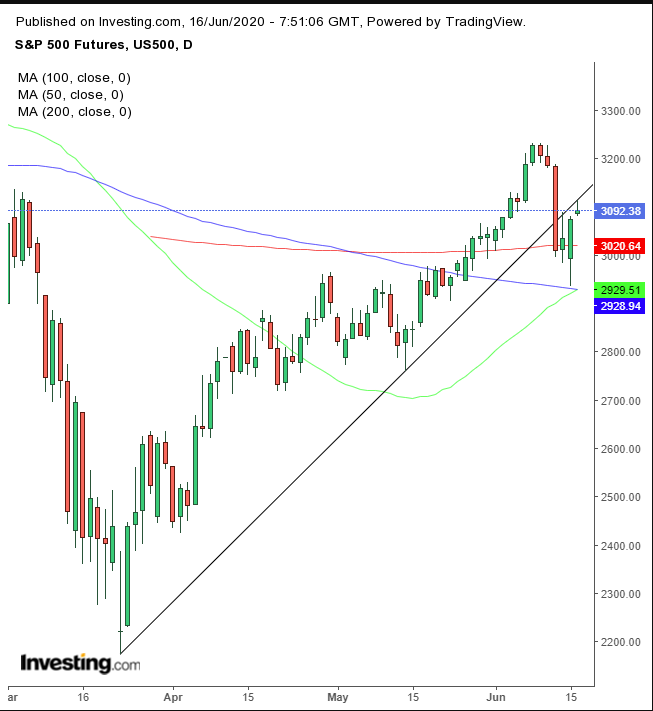
Contracts on the SPX, while remaining above the 200-DMA for a third day, retreated from their broken uptrend line, possibly developing a shooting star.
Gains in travel shares and construction firms boosted the Stoxx Europe 600 Index to a higher open earlier today.
Asian indices all closed higher on Tuesday. South Korea’s KOSPI surged 5.3%, the sharpest advance for the index since March 25, boosted by foreign investors. Japan’s Nikkei jumped 4.9%, after the Bank of Japan announced it will increase its corporate-lending support program. Australia’s ASX 200 added 3.9%. China’s Shanghai Composite lagged, climbing 'only' 1.4%, a rare occurrence of late.
During the Wall Street session on Monday, Fed support pushed the S&P 500 0.8% higher. Earlier, the benchmark index reversed from a 2.5% loss over rising concerns of a second wave of COVID-19.
With risk-appetite restored, investors rotated out of the safety of Treasuries into equities.
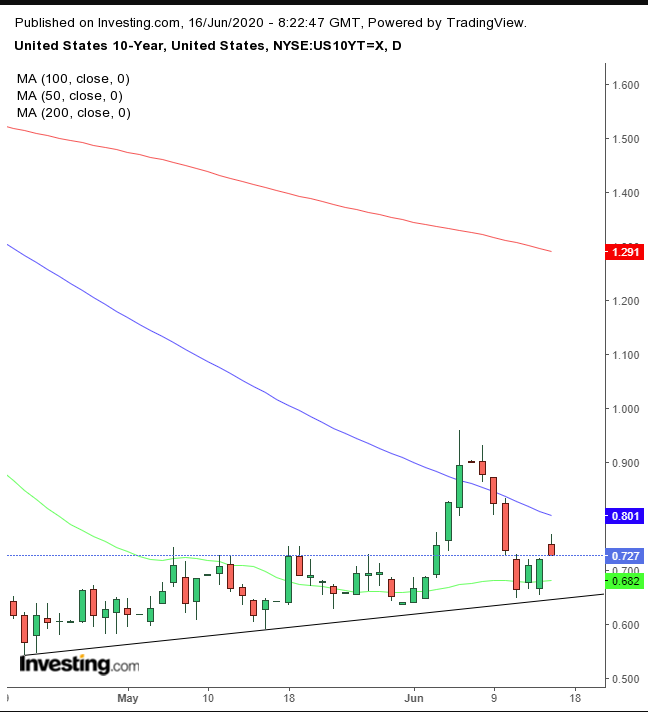
Yields, including for the 10-year note, jumped, extending a rebound off an uptrend line since April 21. The pattern is sandwiched between the 50 and 100 DMAs.
The dollar found its footing after dropping yesterday and ending a two-day advance.
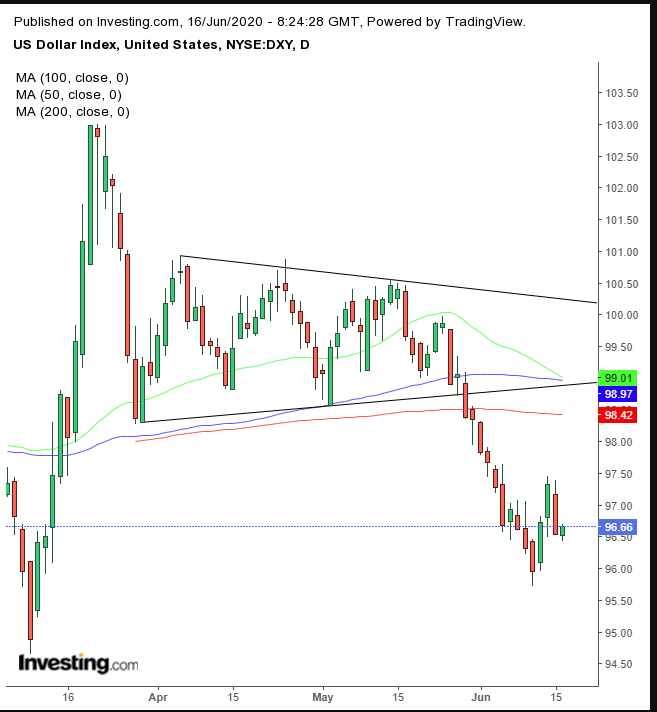
Monday’s reversal suggests the USD is set to resume the implied target of a symmetrical triangle, retesting the March 9 low.
Gold erased all of yesterday’s losses even with risk-on back in effect, due to dollar weakness.

The precious metal has resumed range-trading. A H&S continuation pattern suggests the range will experience a topside breakout.
Bitcoin edged higher.
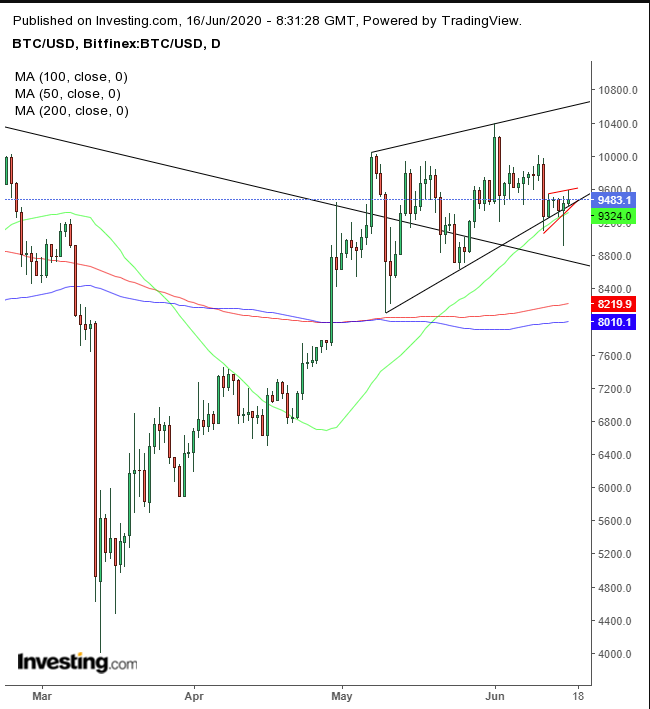
The cryptocurrency's potential rising-flag is struggling against the bottom of a possible rising-wedge. If a downside breakout occurs, it would threaten a return below the downtrend line since last June, after surviving above it for nearly three weeks.
Reduced production, plus new stimulus possibilities, have reenergized the oil market...for now. Of course, global health concerns could always pressure it lower yet again.
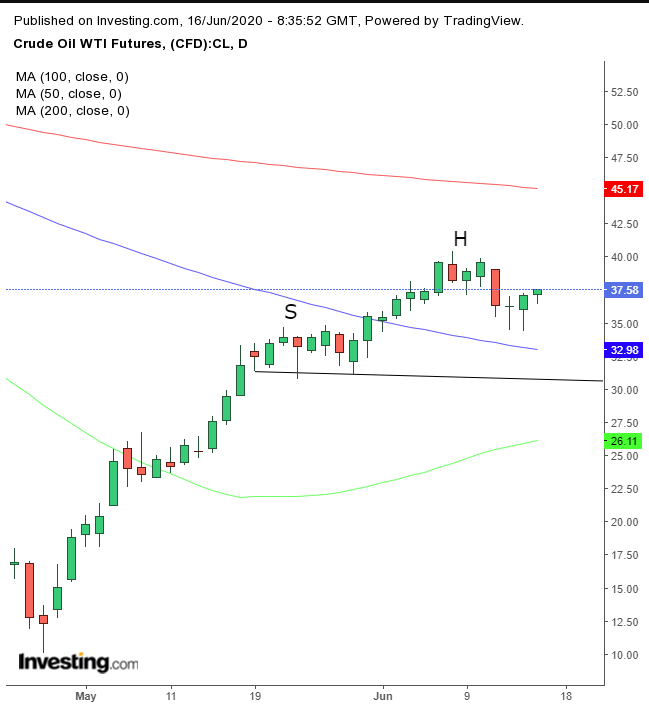
WTI may be developing a H&S top. A fall below $30 would signal a return to selloffs, while clearing the $40 level would put $45 and the 200-DMA in focus.
Up Ahead
- Federal Reserve Chairman Jerome Powell delivers his semi-annual policy report to Congress on Tuesday.
- Policy decisions from the Bank of England and the Swiss National Bank are due later this week.
- The New York Stock Exchange may allow a limited number of market makers to return to its historic trading floor on Wednesday.
Market Moves
Stocks
- The Stoxx Europe 600 Index advanced 2%.
- Futures on the S&P 500 Index rose 0.8%.
- NASDAQ futures gained more than 1%.
- The MSCI Asia Pacific Index climbed 3.3%.
Currencies
- The Bloomberg Index was little changed.
- The euro advanced 0.2% to $1.1347.
- The British pound increased 0.4% to $1.2653.
- The Japanese yen weakened 0.1% to 107.39 per dollar.
Bonds
- The yield on 10-year Treasuries advanced one basis point to 0.73%.
- The yield on two-year Treasuries gained less than one basis point to 0.19%.
- Germany’s 10-year yield gained three basis points to -0.42%.
- Britain’s 10-year yield advanced three basis points to 0.232%.
Commodities
- Brent crude gained 0.1% to $39.74 a barrel.
- Gold strengthened 0.1% to $1,727.47 an ounce.
- Aluminum climbed 1.3% to $1,598 per metric ton.
